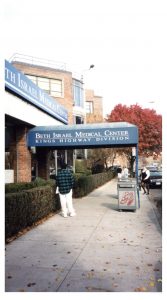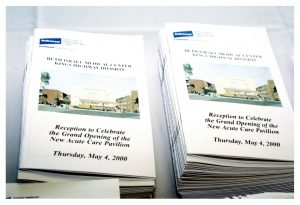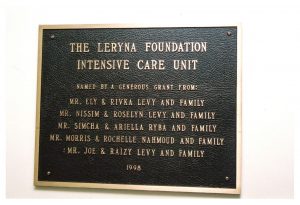Mar 16, 2022
An interactive map of Beth Israel historical locations is available here. See the Building Beth Israel series for more information about the history of MSBI.
Mount Sinai Brooklyn is one of the more recent New York hospitals to join the Mount Sinai Health System. Prior to its most recent incarnation, the hospital dates to the 1950s and was a long-time division of Mount Sinai Beth Israel.
Prior to the 1950s, the location was a series of interlocking lots. In 1953, the parcel was created at 3201 Kings Highway for Samuel Berson, MD, a specialist in allergy and immunology, to create a nursing home there. Though the exact timing is unknown, the nursing home was converted into Kings Highway Hospital shortly after with 212 beds. In 1980, King’s Highway Hospital opened its North wing, without an increase in the number of beds. As a small, private, community hospital, not much documentation has survived from those years.
On July 11, 1994, a special meeting of the Beth Israel Medical Center Board of Trustees passed a resolution “that the Medical Center proceed to negotiate the acquisition of Kings Highway Hospital.” By adding Kings Highway to the existing Petrie and North divisions, “on the basis of total admissions per year, the acquisition makes Beth Israel the largest voluntary hospital in New York City and one of the largest in the United States.”
The period following Beth Israel’s acquisition marked a time of rapid renovation and development at the Kings Highway Division. This included renovations at the Surgi-Center (1996); the introduction of three-bed inpatient Acute Dialysis Unit (November 1996); an expansion of the Russian Health Service and other Russian language amenities (1998); and an expansion of the emergency room from six to seventeen treatment slots (Summer 1998). Perhaps most significant was the groundbreaking for the new building starting in May 1998, which included underground parking, a new emergency department, ICU, and five new operating rooms. The new facility, called the Acute Care Pavilion, was built on what was previously the hospital parking lot, and opened in May 2000.
These renovations and expansions continued with significant investment from donors. In February 1997, Beth Israel Kings Highway Division in Brooklyn received a $150,000 gift from the Leryna Foundation, the family foundation of Ely Levy, an electronics distributor and leader of the Sephardic community in Brooklyn. The gift doubled the number of beds in the ICU from six to twelve. In 1997, the Greater Montreal Convention and Tourism Bureau named Kings Highway Hospital as the beneficiary of proceeds for its production of Robert Lepage’s The Seven Streams of the River Ota at the Next Wave Festival of the Brooklyn Academy of Music. And finally, in December 2002, the Louis Mintz Family Waiting Room in Critical Care Unit was endowed.
With Beth Israel’s merger into the Mount Sinai Health System, the Kings Highway Division was renamed Mount Sinai Beth Israel Brooklyn in January 2014, and then was shortened to Mount Sinai Brooklyn in May 2015. It remains part of the Mount Sinai Health System today.
Sources:
Authored by Stefana Breitwieser with research credit to Nicholas Webb
Mar 2, 2022

Title page of the 1864 Annual Report of the Directors of Jews’ Hospital in New York
Mount Sinai Hospital’s predecessor institution, Jews’ Hospital in New York, was established in 1852, opened in 1855, and initially admitted only people of the Jewish faith and accident victims. A mere twelve years later in 1864 the Board of Directors decided to open the hospital to all, regardless of faith. Then in 1866, to reflect this new policy, the institution changed its name to Mount Sinai Hospital. But why did the Hospital become non-sectarian? At a point in time when many Hospitals founded by other creeds continued their religious affiliations, Jews’ Hospital broke with tradition. It might come as a surprise that the decision to treat people regardless of faith was influenced by the Civil War and the New York City Draft Riots of 1863, one of the “bloodiest race riots in American history.” The profound devastation wrought upon Black people during the gruesome riots shaped New York as we know it today and had a profound impact on the early days of our health system.
In the introduction to The First Hundred Years of The Mount Sinai Hospital of New York, 1852-1952, the authors posit that Jews’ Hospital, as it was in the geographic center of the riots, was “the asylum for their dead and injured. An eventual result for the Hospital was its adoption of the nonsectarianism which has been its policy ever since.” Which begs the question: who did they treat, and did treating victims of the riots actually persuade the Hospital’s Leadership to change its policy? To answer that question, we need to know what occurred in New York City during the years leading up to the 1864 decision. The United States was in the thick of the Civil War which raged from 1861 to 1865. New York City, while positioned as a northern city allied with the Union, was in fact quite a conservative city due to its financial connections to the south.
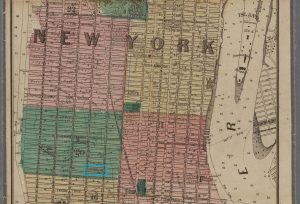
Section 1869 map of New York showing the Jews’ Hospital in blue rectangle (map courtesy of Lionel Pincus and Princess Firyal Map Division, The New York Public Library)
During the Civil War the Jews’ Hospital in New York was located on the south side of 28th Street between 6th and 7th Avenues and admitted on average 30 patients a month. In 1864 the staff consisted of three consulting surgeons, three attending surgeons, four attending physicians, “one resident physician and house surgeon, one superintendent, three nurses, three domestics, and one cook.” Annual reports state that from 1855 to 1860 the Hospital treated 1,285 people. However, during the war years, we are unable to say how many in total were admitted because we do not have annual reports for the years 1861, 1862, and 1863. However, Dr. Teller, House Physician and Surgeon, gave monthly reports on all but a few occasions to The Occident and American Jewish Advocate:
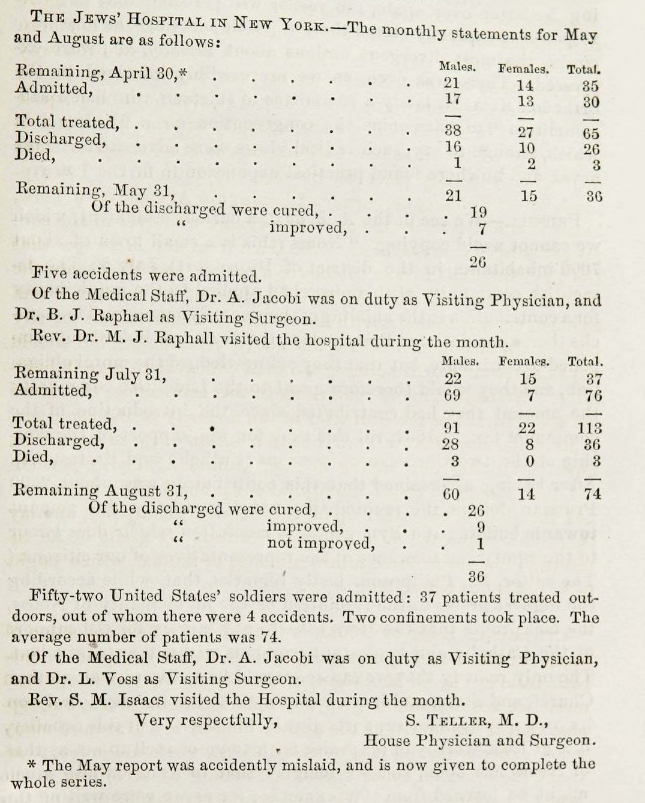
Dr. Teller either did not report the 1863 June and July statistics or the newspaper did not include them. But August, the month after the draft riots, the number of patients treated, 113, is higher than usual.
The Hospital underwent a great transformation during the Civil War. One of its three Attending Surgeons, Dr. Israel Moses, left to serve in the Union Army. Joseph Seligman, who had been on the Hospital’s Board since 1855 resigned his position in 1862 because of his “increasing responsibilities” frequently attending advisory meetings with President Lincoln. The most dramatic change was in 1861 when the Board of Directors resolved to establish a ward for injured Union soldiers, first totaling 48, then 69 beds.
The federal draft law was put into place in the summer of 1863, but it provided an exemption for people who could pay $300 or find someone to take their place. This infuriated the working class, the Irish and other recent immigrants, especially in New York, where Union loyalty was not a given. After the names had been drawn for the first round and published in the weekend’s papers, many New Yorkers were enraged. A large mob formed on the next day, and proceeded to attack and burn down the Provost Marshal’s building, where the draft was taking place. From there the mob moved all around the city, rioting, burning down entire buildings, injuring innocent bystanders, looting and committing outright murder. Described as “bitter street-to-street warfare”, the city was in chaos for four days.
Black people were the primary target of the mob’s atrocious violence due to racism and scapegoating, newspapers having created the narrative that enslaved people, once free, would take jobs from recent immigrants. Mobs lynched eleven Black men, hanging their mutilated bodies from lampposts. The total death count is unknown, but estimates range from over 100 to several hundred. The repercussions of the four days of extreme violence shape New York City even today. Because of the riots, it is estimated that nearly a thousand Black New Yorkers fled Manhattan en masse, seeking permanent refuge elsewhere, leaving behind their homes and communities. In their exodus from what was a racially integrated city, they settled in safer places, such as the historic Black community of Weeksville in Brooklyn (which was a city in its own right at the time). In the aftermath, New York became a more segregated city.
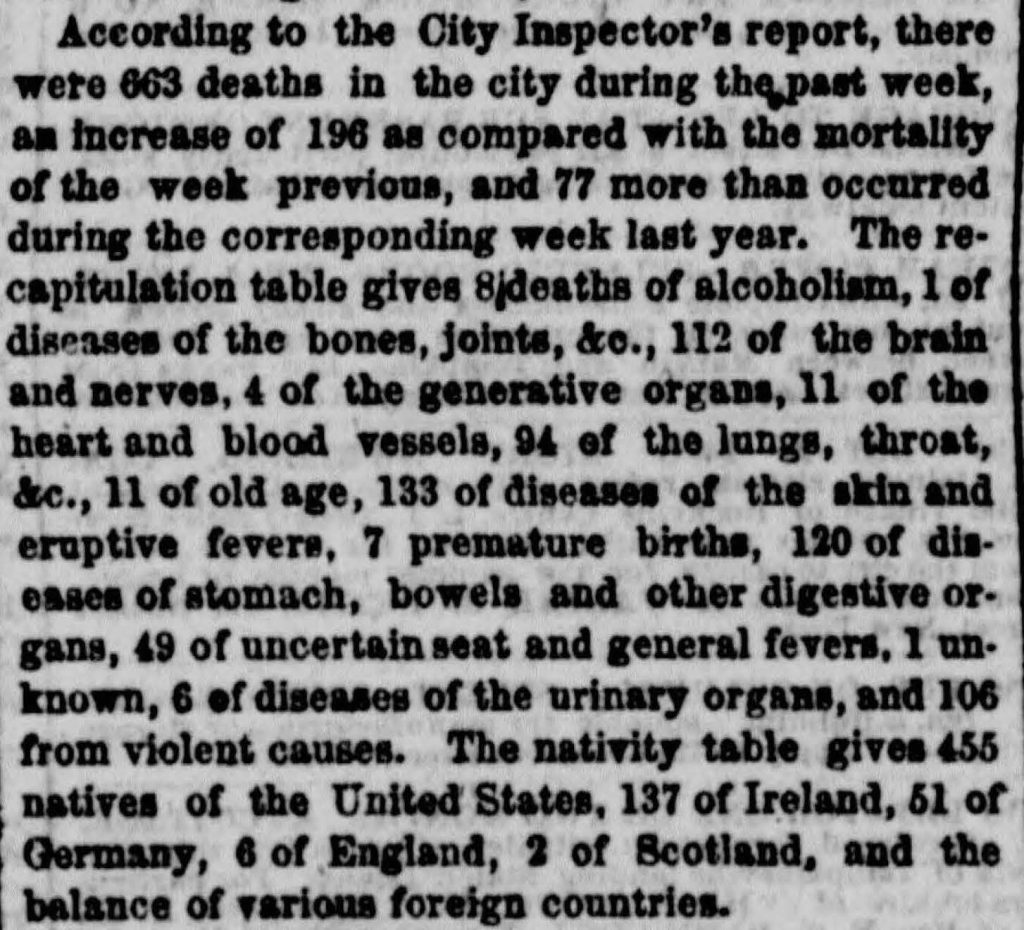
Excerpt from the July 21, 1863 edition of The New York Herald showing 106 deaths from violent causes, presumably the Draft Riots.
One early Mount Sinai doctor recalled:
In the early [1860’s] the hospital must have had its share of the casualties from the draft riots which occurred in the neighborhood, and of which I was in part an eyewitness: the burning of the colored Orphan Asylum in 40th Street, the attack on the Provost Marshall’s office on Broadway and 28th Street, the hanging of a [Black man] to a lamp post at 6th Avenue and 33rd Street, and the escape of frightened colored men, women, and children from the mob to the State Arsenal at 35th Street and Seventh Avenue under protection of a squad of soldiers.
Do we know how many people were treated at the Jews’ Hospital? While the Archives does not possess the case books from that era, we know that, “the geography of the rioting was such that Jews’ Hospital was frequently the center of its fury, and during the bloody days that ensued, it became the sanctuary of the sick and the wounded.” The newspapers of the time described multiple extremely violent events that took place only a few blocks from the Hospital. In all likelihood, the Hospital treated dozens of riot victims and the staff would witness the particular terror and brutal violence inflicted upon Black people.
In reading the minutes’ book entries of the subsequent months, there seems to be no end to the mundane issues the Board of Directors addressed. Rarely is there an explanation of motive or greater historical context included with a decision recorded in such matter of fact reports. However, in the months following the riots, the Hospital’s Board of Directors were:
Sensitive to their obligations to the country and the community during this period, the Board of Directors was also preparing the ground for the nonsectarian policy which has distinguished the Hospital ever since. Accident patients of all nationalities, races and religions had been accepted since the first day of the Hospital’s existence. But the national crisis crystallized the Board’s determination to rise above sectarianism and abolish it completely. In 1864, the Executive Committee had reported, “The Committee deem it proper to observe that many of those admitted to the Hospital were not of our faith, no distinction ever being made as to either the nationality or the religious belief of the sufferer.”
References
Albon P. Man. “Labor Competition and the New York Draft Riots of 1863.” The Journal of Negro History, vol. 36, no. 4, 1951, pp. 375–405. https://doi.org/10.2307/2715371.
Hirsch, Joseph and Doherty, Beka. The First Hundred Years of the Mount Sinai Hospital of New York, 1852-1952. Random House: New York, 1952.
Jews’ Hospital in New York. Annual Report of the Directors of the Jews’ Hospital in New York, 1860. https://archive.org/details/annualreportofdi1860jews/page/18/mode/2up
Meyer, Alfred. “Recollections of Old Mount Sinai Days.” Journal of the Mount Sinai Hospital, vol. 3, no. 6, 1937, pp. 295-307.
Authored by J.E. Molly Seegers

